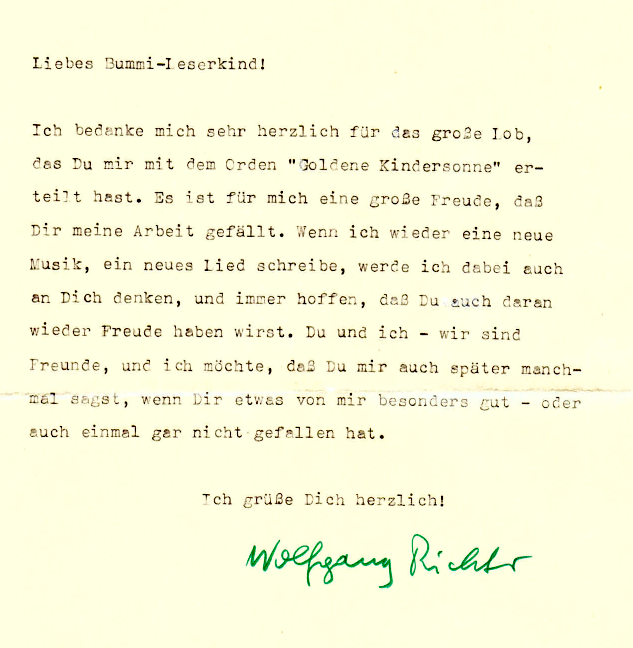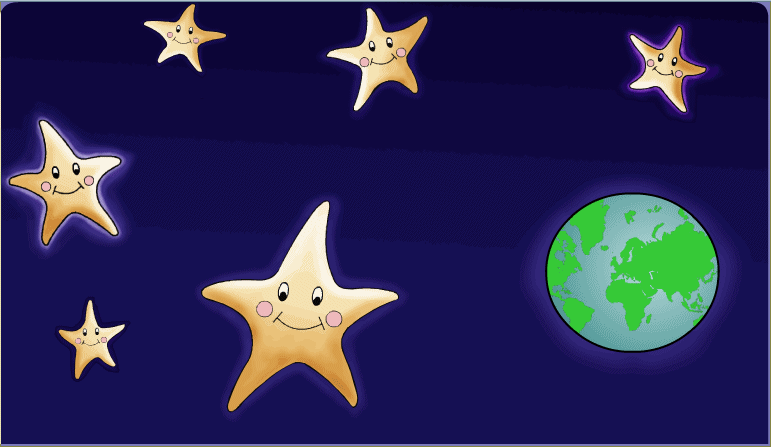|
Bummi-Lied
The "Bummi-Lied" (German for: „Bummi-Song“) with its opening line „Kam ein kleiner Teddybär..“ („Came a little Teddy bear“..) is a Kinderlied from the GDR with 5 stanzas. The text was written by Ursula Werner-Böhnke, main contributing editor of the children's magazine Bummi. The melody was composed by Hans Naumilkat. The text is a reference to the main character of the eponymous children's magazine, the yellow teddybear „Bummi“. The magazine was created in 1957 for children in kindergarten Kindergarten is a preschool educational approach based on playing, singing, practical activities such as drawing, and social interaction as part of the transition from home to school. Such institutions were originally made in the late 18th cent ... age. From 1969 onwards, the tune was part of the educational system for primary school starters with a slightly to 3 stanzas shortened version. The written text was published by VEB Friedrich Hofmeister Musikverlag Leipzig. Li ... [...More Info...] [...Related Items...] OR: [Wikipedia] [Google] [Baidu] |
Bummi (magazine)
''Bummi'' is the title of a German magazine for children in kindergarten age. The eponymous hero ''Bummi'' is an upright walking, yellow-furred teddy bear. ''Bummi'' was first published on 15 February 1957 as a monthly in the GDR. From 1965 onwards, it was published biweekly and cost 0.25 Mark. It had a run of 736,300 copies in . The magazine was officially published and supported by the central organisation of the FDJ with the aimed at age group of children from 3 to 6 years. It was sold at kiosks and ordinary magazine stands. The eponymous title character was designed by Ingeborg Meyer-Rey. long-serving main contributing editor Ursula Werner-Böhnke wrote the lyrics to the Bummi-Lied, to which the melody was composed by Hans Naumilkat Hans Christoph Karl Friedrich Naumilkat (9 December 1919 – 13 February 1994) was a German composer and music educator. Life Born in Schönebeck, Naumilkat passed his Abitur in 1938 and subsequently studied music and music education ... [...More Info...] [...Related Items...] OR: [Wikipedia] [Google] [Baidu] |
Hans Naumilkat
Hans Christoph Karl Friedrich Naumilkat (9 December 1919 – 13 February 1994) was a German composer and music educator. Life Born in Schönebeck, Naumilkat passed his Abitur in 1938 and subsequently studied music and music education in Braunschweig, Berlin and Halle. After the Second World War, Naumilkat headed the folk music department, the music department of children's radio and the children's choirs of the Berliner Rundfunk, which were founded in 1950. He worked as a freelance composer and from 1957 as a music teacher. In 1966, he was appointed as professor and from 1968 to 1974, he directed the "Ensemble Etkar André" at the in Berlin. From 1974, he was choirmaster and music teacher at the . on AllMusic Naumilkat composed mainly vocal works for his choirs, for school practice and for the GDR pioneer organisa ... [...More Info...] [...Related Items...] OR: [Wikipedia] [Google] [Baidu] |
German Language
German ( ) is a West Germanic languages, West Germanic language mainly spoken in Central Europe. It is the most widely spoken and Official language, official or co-official language in Germany, Austria, Switzerland, Liechtenstein, and the Italy, Italian province of South Tyrol. It is also a co-official language of Luxembourg and German-speaking Community of Belgium, Belgium, as well as a national language in Namibia. Outside Germany, it is also spoken by German communities in France (Bas-Rhin), Czech Republic (North Bohemia), Poland (Upper Silesia), Slovakia (Bratislava Region), and Hungary (Sopron). German is most similar to other languages within the West Germanic language branch, including Afrikaans, Dutch language, Dutch, English language, English, the Frisian languages, Low German, Luxembourgish, Scots language, Scots, and Yiddish. It also contains close similarities in vocabulary to some languages in the North Germanic languages, North Germanic group, such as Danish lan ... [...More Info...] [...Related Items...] OR: [Wikipedia] [Google] [Baidu] |
Teddy Bear
A teddy bear is a stuffed toy in the form of a bear. Developed apparently simultaneously by toymakers Morris Michtom in the U.S. and Richard Steiff under his aunt Margarete Steiff's company in Germany in the early 20th century, the teddy bear, named after President Theodore Roosevelt, became a popular children's toy and has been celebrated in story, song, and film. Since the creation of the first teddy bears which sought to imitate the form of real bear cubs, "teddies" have greatly varied in form, style, color, and material. They have become collector's items, with older and rarer teddies appearing at public auctions. Teddy bears are among the most popular gifts for children and are often given to adults to signify affection, congratulations, or sympathy. History The name ''teddy'' ''bear'' comes from former United States President Theodore Roosevelt, who was often referred to as "Teddy" (though he loathed being referred to as such). The name originated from an incident on a ... [...More Info...] [...Related Items...] OR: [Wikipedia] [Google] [Baidu] |
Children's Song
A children's song may be a nursery rhyme set to music, a song that children invent and share among themselves or a modern creation intended for entertainment, use in the home or education. Although children's songs have been recorded and studied in some cultures more than others, they appear to be universal in human society. Categories Iona and Peter Opie, pioneers of the academic study of children's culture, divided children's songs into two classes: those taught to children by adults, which when part of a traditional culture they saw as nursery rhymes, and those that children taught to each other, which formed part of the independent culture of childhood. A further use of the term ''children's song'' is for songs written for the entertainment or education of children, usually in the modern era. In practice none of these categories is entirely discrete, since, for example, children often reuse and adapt nursery rhymes, and many songs now considered as traditional were deliberatel ... [...More Info...] [...Related Items...] OR: [Wikipedia] [Google] [Baidu] |
Kindergarten
Kindergarten is a preschool educational approach based on playing, singing, practical activities such as drawing, and social interaction as part of the transition from home to school. Such institutions were originally made in the late 18th century in Germany, Bavaria and Alsace to serve children whose parents both worked outside home. The term was coined by German pedagogue Friedrich Fröbel, whose approach globally influenced early-years education. Today, the term is used in many countries to describe a variety of educational institutions and learning spaces for children ranging from 2 to 6 years of age, based on a variety of teaching methods. History Early years and development In 1779, Johann Friedrich Oberlin and Louise Scheppler founded in Strasbourg an early establishment for caring for and educating preschool children whose parents were absent during the day. At about the same time, in 1780, similar infant establishments were created in Bavaria. In 1802, Princess P ... [...More Info...] [...Related Items...] OR: [Wikipedia] [Google] [Baidu] |
Friedrich Hofmeister Musikverlag
Friedrich Hofmeister Musikverlag (abbreviated to Hofmeister) is a publisher of classical music, founded by Friedrich Hofmeister in Leipzig in 1807. Early listings included composers Ludwig van Beethoven, Frédéric Chopin and Franz Liszt. Hofmeister was the first to publish Mahler's Second Symphony. Pedagogical works, such as a Violinenschule of Hubert Ries (1841), are still in use. The company sells sheet music internationally, including Asia and America. History Friedrich Hofmeister, born in 1787, first founded a music store in Leipzig in April, 1807. Early listings include composers Ludwig van Beethoven, Luigi Cherubini, Franz Anton Hoffmeister, Carl Maria von Weber, Johann Nepomuk Hummel, John Field and Franz Liszt. In the early years, he published a balance of music by popular composers, pedagogical material, and young composers such as Robert Schumann, Chopin, Clara Wieck-Schumann and Hector Berlioz. Pedagogical volumes included a Gitarrenschule (guitar) by Jo ... [...More Info...] [...Related Items...] OR: [Wikipedia] [Google] [Baidu] |




.jpg)